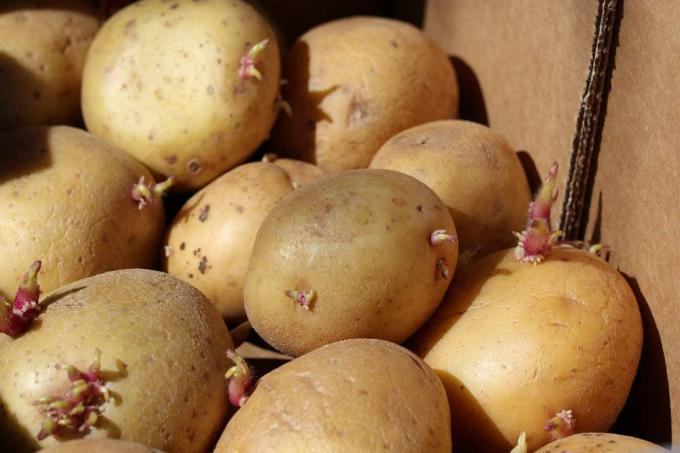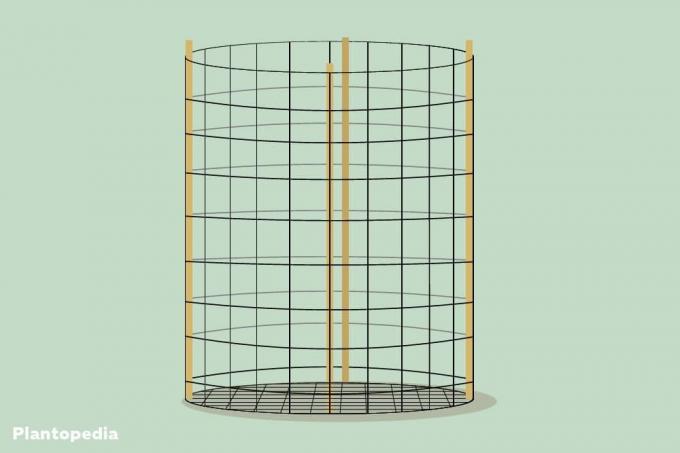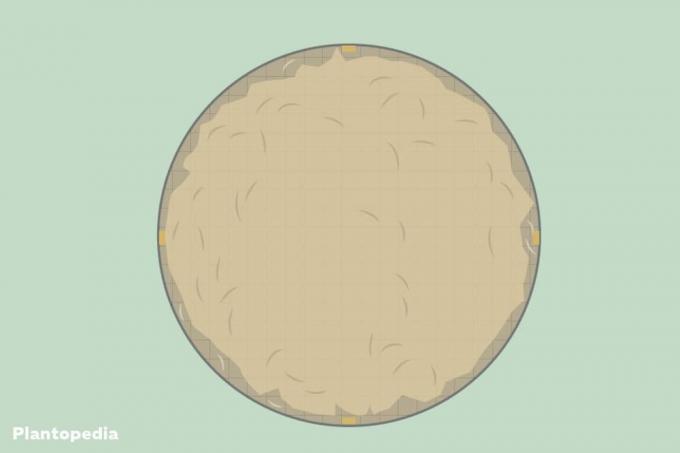
table of contents
- Potato tower
- Location
- material
- Building a potato tower: instructions
- shell
- Assembly
- 1. Lay out the subsurface
- 2. Lay out walls
- 3. Fill in soil
- 4. Fill the turret
- 5. filling in layers
- care
- harvest
Potatoes can be grown in beds, but they usually require a lot of space. However, if you only have limited space or no garden, you do not have to do without potatoes from your own cultivation! Because with a potato tower, the popular tubers can be grown not only to save space in the garden, but even on the terrace or even the balcony! We have created simple instructions for you with which you can build a potato tower in just a few steps.
Potato tower
A potato tower is a construction that is similar to a raised bed, but is specially designed for growing potatoes. These are available in different versions in the trade, but these can also be inexpensive and easy to build yourself. The yield is also impressive, because up to 20 fresh potatoes can be grown from one ordinary potato. All in all, the numerous advantages speak for themselves:
- very space saving
- inexpensive
- simple structure
- decorative
- very easy to care for
- reusable
Which potato is suitable?
Unlike tomatoes and the like, the potato is not sown, but planted as a seed potato. This means that the whole potato is used instead of the seeds. No specific specimens are required for cultivation, because both seed potatoes and common organic potatoes are suitable. However, the best way to grow them is with pre-sprouted potatoes:
- from mid-April
- Put the potatoes in the soil
- about 8-10 cm deep
- sufficient distance to each other

tip: If the potato is placed in the garden for pre-germination, it should also be covered with foil. Because this protects the shoots from possible frost.
Location
The potato tower can be placed on the balcony or in the garden. If the tower is to be given a place in the bed, this does not have to be dug up beforehand. Because it is usually sufficient to shorten the plants a little. Although the location of the potato tower can be freely selected, the following points should still be taken into account:
- as sunny a place as possible
- Underground earth or race
- Gravel is also possible
- it is important that the water can drain away
material
A self-made potato tower not only has the advantage that the dimensions can be perfectly matched to the available space. Because the choice of materials and thus the appearance of the turret can also be chosen according to your own preferences. From simple potato towers to constructions made of stone, everything is possible. However, the following material is required to build a simple potato tower:
- Mats made of reed, bamboo, plastic or screed
- Rabbit or wire mesh
- Garden soil
- compost
- Straw, old newspapers or dried grass clippings
- cable ties
- Bamboo sticks
Note: If you want to build a potato tower with a diameter of around 60 centimeters, you need mats that are around one meter high and almost two meters long.
Building a potato tower: instructions
shell
The first step in the construction plan is to make the Shell construction. For this purpose, the mat or the wire first formed into a cylinder. Then the edges of the respective material are joined together and fastened with cable ties. Alternatively, you can of course also attach this with a conventional wire. Once the shell is finished, it can be moved to the future location:
- Line the floor with wire
- alternatively spread with a foil with small holes
- this allows the water to drain away
- Set up and fix the shell
- Place 3-4 bamboo sticks along the inner edge
- or anchor the grid with small hooks in the ground

Assembly
When the potato tower has been set up and fixed, it is time to equip it. With this, however, you should be up after the ice saints wait, because potatoes don't like frost. The time of stocking also depends on the respective potato variety: Early potatoes are generally planted earlier than late varieties. In order to achieve the highest possible yield from the turret, assembly in layers has proven its worth:
1. Lay out the subsurface
The first layer of the potato tower has a protective function. On the one hand, it should keep the warmth in the turret and, on the other hand, it prevents the muddy earth from reaching the bottom. To do this, lay out a 30 centimeter layer made of one of the following materials:
- hay
- dried grass clippings
- Sheep wool
- old newspapers
- cardboard

tip: You can put large stones on top of the first layer to provide additional stability.
2. Lay out walls
It is advisable to line the walls of the tower as well. Because this ensures that the earth is not washed out. However, you should make sure to keep the layer as thin as possible. This enables the growing potato plants to find loopholes and to drive them out nicely.
- Line the entire inner edge with hay
- alternatively, rhubarb leaves are suitable
- as thin a layer as possible
3. Fill in soil
Now it is time to fill the turret with substrate. Ideally, a mixture of soil and ripe compost is used at this point. Because this gives the potatoes valuable nutrients, which in turn promote growth and thus the yield. If you want to use ordinary garden soil, you can also upgrade it as follows:
- First lay out a thin layer of horn shavings
- then put on garden soil
- Pour water lightly
- this gives the soil moisture

4. Fill the turret
In this step, the individual potatoes are used. However, you should by no means just randomly plant them in the ground! It is better to use the tubers according to a system so that they have enough space to grow:
- about 4-8 potatoes per layer
- insert in a circle
- Distance to the edge about 4 cm
- sufficient distance to each other!
- Cover the potatoes with a thin layer of soil
tip: It is advisable to mark this layer with a stick or a clamp. This means that the hobby gardener knows where the respective layer is and can later harvest it more easily.

5. filling in layers
After the first layer of potatoes, the individual layers are now repeated. In doing so, you lay out a layer of hay about five centimeters high and a layer of soil about 10 centimeters high, in which you in turn place the potatoes. This is repeated until the last layer is about 25 to 30 centimeters below the edge. The following should also be noted for the last two shifts:
- No longer just use potatoes in circles
- but also about 3-4 potatoes in the middle
- Finally, wrap the tower with bamboo mats
- Close the ends with cable ties
- Cut off the excess of the mat
- water well, about 30-40 liters

care
One of the many advantages of potato towers is that they are extremely easy to care for. Because basically all you have to do is pour the tower. Every now and then it can happen that the potato plants need a little more space. It is then necessary to break individual rods out of the mats or to cut slots in the mats. In general, however, it can be said that care is designed as follows:
- water regularly, but not too often
- 1x a week is sufficient
- Avoid waterlogging

tip: Snails are extremely fond of the potato plants, which is why they keep looking for their way to the tubers. It is therefore advisable to regularly check the construction for snails and to remove them.
harvest
You can harvest the first potatoes from late summer until autumn. To do this, you can simply open the potato tower so that the potatoes literally roll out. However, this method also has the disadvantage that the earth and straw also roll out. If you want to carry out the harvest in a more controllable manner, you can use the following method:
- Remove layer by layer
- with hands or shovel
- Take out the ripe potato
- Earth and straw on compost
- Dismantle the tower
Note: In the following year it is not necessary to build a new potato tower. Because the old turret is reusable and can therefore be put up again next spring.


